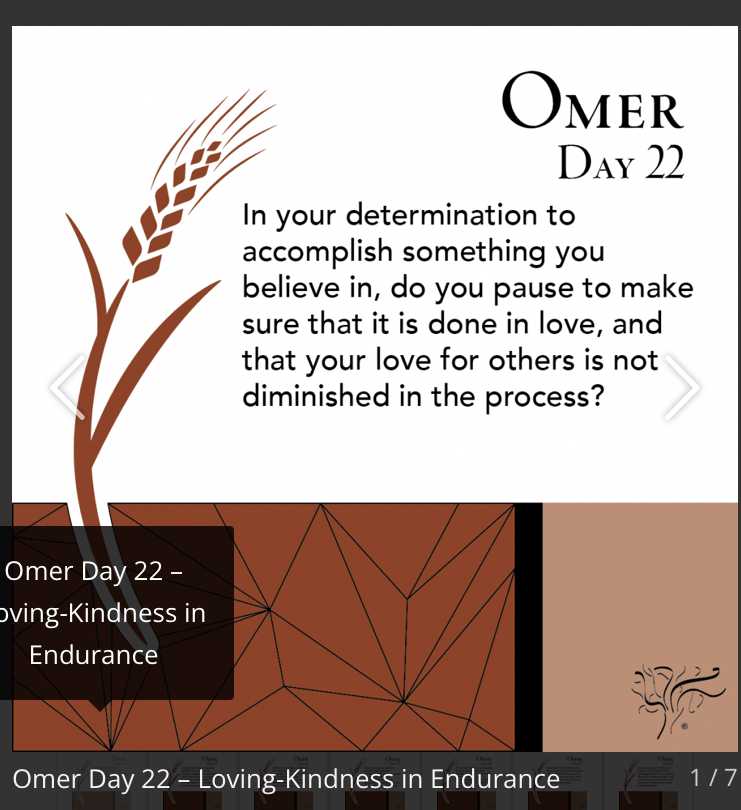Watch
Events
Articles
Market
More
Chesed of Netzach
Endurance and ambition is a combination of determination and tenacity. It is a balance of patience, persistence and guts. Endurance is also being reliable and accountable, which establishes security and commitment. Without endurance, any good endeavor or intention has no chance of success.
Endurance means to be alive, to be driven by what counts. It is the readiness to fight for what you believe, to go all the way. Without such commitment any undertaking remains flat and empty. It is an energy which comes from within and stops at nothing to achieve its goals. This, of course, requires that endurance be closely examined to ensure that it is used in a healthy and productive manner.
Ask yourself: How committed am I to my values? How much would I fight for them? Am I easily swayed? What price am I ready to pay for my beliefs? Is there any truth for which I would be ready to give my life?
Effective endurance needs to encompass the following seven ingredients: love, discipline, compassion, endurance, humility, bonding and dignity. The problems people have with endurance and commitment are due to a lack of one or more of these seven components.
Day One of Week 4: Chesed of Netzach
For anything to endure it needs to be loved. A neutral or indifferent attitude will reflect in a marginal commitment. If you have difficulty making commitments, examine how much you love and enjoy the object that requires your commitment. Do I love my work? My family? My choices?
For endurance to be effective it needs to be caring and loving. Endurance without love can be counterproductive. Raw endurance can come across as harsh and aggressive, which undermines the cooperation of others. Out of sheer determination one may often become controlling and demanding, driving others away. For endurance to be successful it needs a loving and caring attitude, it requires patience.
Does my endurance cause me to be, or seem to be, inflexible? Does my drive and determination cause me to be controlling? Am I too demanding? Do others (my employees, friends, children) cooperate with me out of the sheer force of my will and drive, or out of love? Is my endurance unloving? In order to get my way would I allow others to get hurt? Do I believe that the end justifies the means? Would I stop at nothing to achieve my goals? When my endurance prevails and I overcome the obstacles in my way, am I still loving? Even when defending myself and others against unhealthy influences, am I driven by love or hate (see week two, day one)?
Exercise for the day: When fighting for something you believe in, pause a moment to ensure that it is accomplished in a loving manner.




Chesed of Netzach
Endurance and ambition is a combination of determination and tenacity. It is a balance of patience, persistence and guts. Endurance is also being reliable and accountable, which establishes security and commitment. Without endurance, any good endeavor or intention has no chance of success.
Endurance means to be alive, to be driven by what counts. It is the readiness to fight for what you believe, to go all the way. Without such commitment any undertaking remains flat and empty. It is an energy which comes from within and stops at nothing to achieve its goals. This, of course, requires that endurance be closely examined to ensure that it is used in a healthy and productive manner.
Ask yourself: How committed am I to my values? How much would I fight for them? Am I easily swayed? What price am I ready to pay for my beliefs? Is there any truth for which I would be ready to give my life?
Effective endurance needs to encompass the following seven ingredients: love, discipline, compassion, endurance, humility, bonding and dignity. The problems people have with endurance and commitment are due to a lack of one or more of these seven components.
Day One of Week 4: Chesed of Netzach
For anything to endure it needs to be loved. A neutral or indifferent attitude will reflect in a marginal commitment. If you have difficulty making commitments, examine how much you love and enjoy the object that requires your commitment. Do I love my work? My family? My choices?
For endurance to be effective it needs to be caring and loving. Endurance without love can be counterproductive. Raw endurance can come across as harsh and aggressive, which undermines the cooperation of others. Out of sheer determination one may often become controlling and demanding, driving others away. For endurance to be successful it needs a loving and caring attitude, it requires patience.
Does my endurance cause me to be, or seem to be, inflexible? Does my drive and determination cause me to be controlling? Am I too demanding? Do others (my employees, friends, children) cooperate with me out of the sheer force of my will and drive, or out of love? Is my endurance unloving? In order to get my way would I allow others to get hurt? Do I believe that the end justifies the means? Would I stop at nothing to achieve my goals? When my endurance prevails and I overcome the obstacles in my way, am I still loving? Even when defending myself and others against unhealthy influences, am I driven by love or hate (see week two, day one)?
Exercise for the day: When fighting for something you believe in, pause a moment to ensure that it is accomplished in a loving manner.




Thought for Today: Sunday April 30:
YHVH has a plan for peace and it is found in His Son, whom the Scriptures calls the [Prince of Peace] – Isaiah 9:6. But us humans has rejected His plan. Wars still ravage our world – and our lives. Why? Yeshua said the problem is within us… Our real war is a rebellion against YHVH Elohiym – and it brings unending misery. But YHVH longs to see this rebellion cease… This happens as we repent and receive Moshiach. The war is over, for YHVH extends a peace treaty to all who come to Moshiach.



SERIES N --- THE EXILE --- LESSON 13
HEZEKIAH’S DEATH
THE DEATH OF KING HEZEKIAH
From 2 Kings 20; 2 Chronicles 32:24-33
King Hezekiah became so sick with a boil that he was dying. When Isaiah the prophet went to see the king, he told him, [Adonai says you are dying. You must put your affairs in order and prepare for death, for you are not going to get well.] Hearing that, Hezekiah turned his face to the wall and began to pray. [Remember how I have been faithful to You, Adonai,] he prayed. [Remember how I have walked before You with all my heart and how I have tried to do what You want.] And then he cried bitterly. Before Isaiah left the palace courtyard, Adonai spoke to him again. [Go back to King Hezekiah, leader of My people, and tell him that Adonai has heard his prayers and seen his tears and will heal him. On the third day he will be well enough to go to the temple, the house of Adonai. I will give Hezekiah fifteen more years of life and will spare Jerusalem from the king of Assyria for My sake and the sake of My servant David.] Isaiah returned to Hezekiah and told his servants, [Take a cake of figs and place it on his boil, and so he will get well.] [What sign will Adonai give that He will heal me?] Hezekiah asked. [How can I know that I shall go to the temple in three days?] [Adonai will give you a sign,] Isaiah said. [You may choose that the shadow of the sundial on the steps of Ahaz either go forward ten steps or backward ten steps.] At that time some of the sundials were made like small stairways. People could tell the time of day by the place where the shadow fell on the steps. [It is easy for the shadow to go forward,] Hezekiah answered. [Please let it go backward ten steps.] Isaiah prayed to Adonai, and He caused the shadow on the sundial of Ahaz to go backward ten steps. When Merodach-baladan, the son of King Baladan of Babylon, learned of Hezekiah’s sickness, he sent ambassadors with a letter and a gift. Hezekiah welcomed them and showed them his palace, including the treasure house with its silver, gold, spices, aromatic oil, and the king’s armoury. In fact, he showed them everything he had. Isaiah went to see Hezekiah and asked, [What did these men say, and where did they come from?] [From Babylon,] Hezekiah told him. [What did they see in your palace?] Isaiah asked. [Everything,] Hezekiah answered. [I showed them all my treasures.] [Then listen to the Word of Adonai,] said Isaiah. [A time will come when everything in your palace, including all the treasures of your ancestors, will be taken to Babylon. Nothing will be left. They will even take your sons and when they have made eunuchs of them, they will force them to serve in the palace of the king of Babylon.] [What Adonai says is good,] Hezekiah answered. For Hezekiah was thinking, [It is good that there will be peace as long as I live.] Hezekiah became rich and famous. He had so much treasure that he had to build special treasury buildings for his silver, gold, precious stones, spices, shields, and other precious articles. He also built storehouses for the grain, wine, and oil, as well as stalls for his cattle, herds, and flocks. He built special cities for himself, for Adonai gave him great wealth. Hezekiah closed the upper outlet of the Gihon Spring and directed it through a tunnel to the western side of the City of David portion of Jerusalem. Hezekiah prospered in everything he did. The other part of Hezekiah’s biography is found in the Book of the Chronicles of the Kings of Judah and Israel and in the writings of Isaiah the prophet, the son of Amoz. When Hezekiah died, he was buried in the royal tombs in the hillside of Jerusalem, along with the previous kings. Jerusalem paid him great honour at his death. Then his son Manasseh became king in his place.
COMMENTARY
HEZEKIAH’S WATER TUNNEL
When Sargon II’s son Sennacherib took the Assyrian throne, the western countries revolted against Assyrian power. Among those who refused to surrender the required tribute was King Hezekiah of Judah. Hezekiah began preparing for an Assyrian assault, clearly expecting a long siege. He filled storehouses with food, reorganized his army, increased production of weapons, and reinforced Jerusalem’s walls. But the most outstanding of his defences was an underground tunnel built to channel water into the city. Jerusalem’s water came from the Gihon Spring, which lay in the undefended Kidron Valley. A reservoir was first prepared inside the city’s south-eastern defences. With one crew at the reservoir and another at the spring, workmen began chipping away at the limestone rock. Work space in the tunnel was barely large enough to swing an axe, and men working underground had neither instruments nor maps to guide them. Only some shafts, sunk hundreds of years earlier by the city’s Jebusite inhabitants and connected by corridors, made the work somewhat easier. Otherwise, the task was enormous. The entire mountain spur on which Jerusalem was built had to be tunnelled through, and veins of hard rock forced a winding route of almost double the actual distance. About six months were required to complete the tunnel. Hezekiah blocked the spring’s flow in the valley, so the Assyrians could not use the water or block Jerusalem’s life-giving supply.



There's a pretty song by OwlCity called "The Meadow Lark". The story of the song is that two soldiers meet in a forest, point their guns at each other, then decide not to kill each other and leave. The song says this is Christ's command to "love your enemy", and showing the grace that Christ showed to you.
With the scenario itself, the problem doesn't come so much from them not killing each other as from both of them leaving. Neither of them surrendered, they made no truce to not take part in that war, or anything of the kind. They were both still soldiers, still at war, and each let the other go continue in this: in doing so each betrayed all they were fighting for, and placed their fellow soldiers if not their loved ones in the line of fire.
And then the claim that not killing an enemy in war is "loving your enemies": to say this one must not only say that killing is always wrong, one must specifically say that killing to save and protect life is wrong.
Even more than it is frowned upon in Scripture to avenge oneself, it is our vehemently established duty to avenge others; yet it is surprising how often people confuse these opposite principles. Blessing them that curse you is far from, if not the opposite of, blessing those that curse others. An enemy in war is in a way the farthest one can get from someone who is your personal enemy.
I wrote a short-story based on the OwlCity song - be warned, as a story of war, it is graphic.
And here's the song, for the curious:
2023/04/29 #sabbathposts


